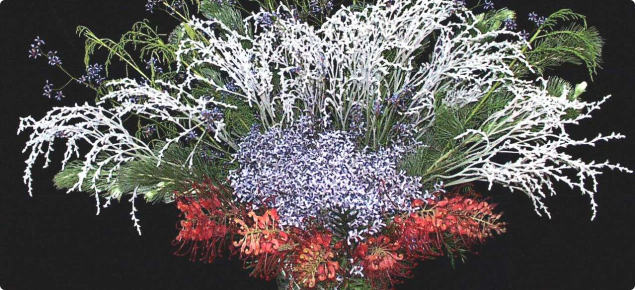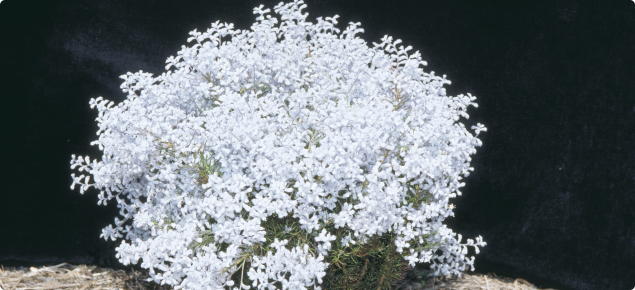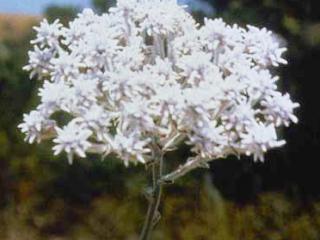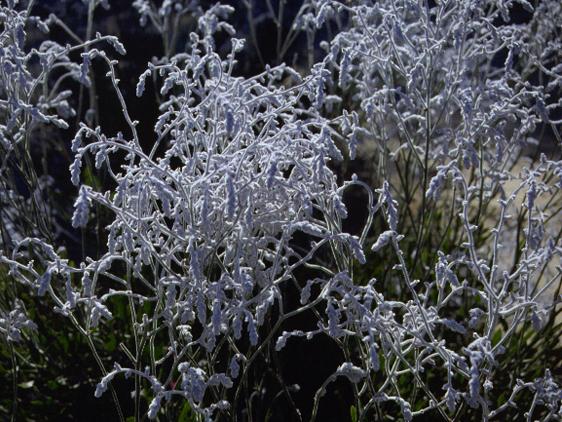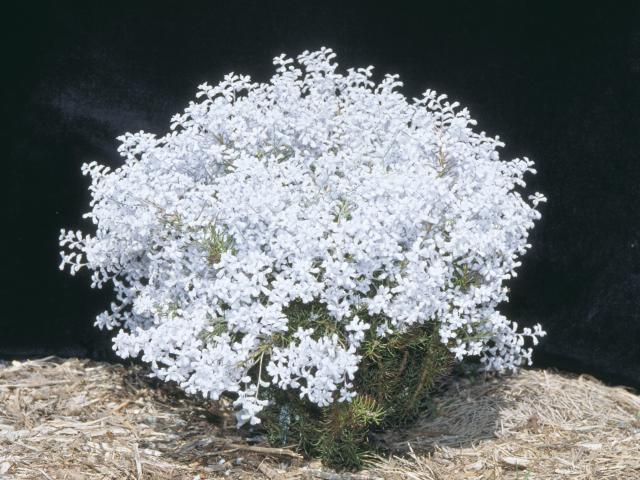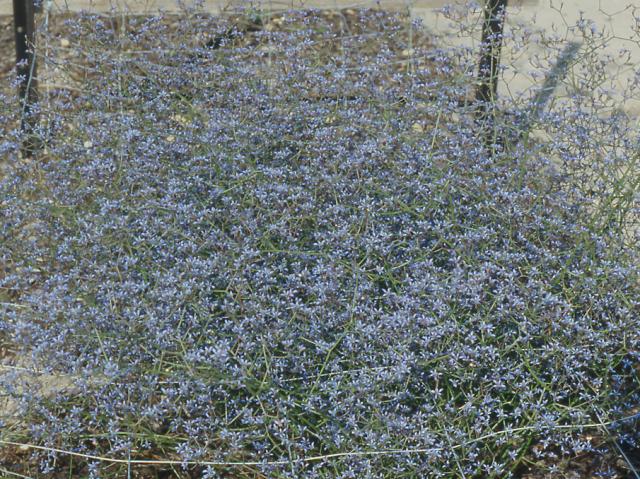Introduction
Smokebushes are in the family Proteaceae and members of the genus Conospermum.
They offer a wide diversity of flower types, ranging from white to blue and flowering from summer to winter.
They are almost entirely picked from natural populations and exported fresh or dried to Japan, Europe and the USA.
Species selection
Six species of conospermum have been selected that can be grown as cutflowers. These include both blue flowering types, Conospermum eatoniae (blue lace) and C. caeruleum (slender smokebush), and white or grey flowering types, C. triplinervium (tree smoke), C. stoechadis (common smokebush), C. incurvum (plume smokebush) and C. crassinervium (tassel smokebush). Not many of these flowers are commercially available today.
Tables 1a and 1b indicate the main characteristics of these six species.
| Species | Conospermum eatoniae | Conospermum caeruleum |
|---|---|---|
| Common name | Blue lace | Slender smokebush |
| Growth habit | Upright | Spreading |
| Flowering period | July-August | July-October |
| Average production | High: more than 50 stems per plant | Medium: 25-50 stems |
| Comments | Prefers warm climates; in high demand | Prefers cooler climates; packs well |
| Species | Conospermum crassinervium | Conospermum triplinervium | Conospermum stoechadis | Conospermum incurvum |
|---|---|---|---|---|
| Common name | Tassel smokebush | Elk smokebush | Common smokebush | Plume smokebush |
| Growth habit | Upright | Upright | Spreading to upright | Spreading to upright |
| Flowering period | December-February | August-November | July-October | August-October |
| Average production | Low: less than 25 stems per plant | High: more than 50 stems per plant | High: more than 50 stems per plant | Medium: 25-50 stems per plant |
| Comments | Late flowering; dries well | Wide area suitability; range of types | High stem production | Small shrub; attractive flowers |
- Conospermum eatoniae has leafless stems with masses of clusters of china blue flowers and is sought after on Japanese markets.
- C. caeruleum has large flat leaves that remain on stems, with fewer blue flower clusters than C. eatoniae.
- C. stoechadis has a grey/white flower panicle and narrow leaves and is a high stem producer.
- C. triplinervium comprises a number of species with broad leaves and various forms from weeping to strong upright stems. One particular form has heavy stems and white hairy flowers and has been named the ‘elk’ smokebush.
- C. incurvum is a smaller plant than C. triplinervium or C. stoechadis and has spikes of leafless stems covered in white flowers with a black tip to the perianth.
- C. crassinervium grows fairly slowly and produces flowers in a corymb forming a tassel. It flowers in summer but continues to flower over an extended period in cultivation.
Climate
Smokebushes can be grown in a wide range of rainfall zones from 350 to 850mm and maximum/minimum average temperatures of 23/10°C. However, stem production may be lower and the flowering period may be shorter if conditions are too extreme.
For example, C. eatoniae performs better in drier, warmer regions while C. caeruleum flowers for longer in cooler regions. Smokebush has some frost tolerance.
Site requirements
Choose a weed and disease-free site, preferably one with minimal or no previous fertiliser history.
Smokebush prefers free-drained, deep acid sand (pHCa 5.8 to 6.8).
It is fairly intolerant of residual soil phosphorus. Some species will tolerate free draining loamy soils.
Early weed control is required to reduce weed presence significantly. This can be achieved by cultivation, knockdown herbicides such as glyphosate and Spray.Seed®, and a pre-emergence treatment.
Planting and establishment
Weed control needs to be maintained during establishment to ensure plant survival.
Weedmat® can be used, while laying 75 to 100mm of bark mulch aids establishment, suppresses weeds, conserves soil moisture and reduces soil temperature during summer.
The use of covers such as ‘grow cones’ or similar tree guards aids establishment, particularly on windy sites, and can discourage native animals from nibbling young foliage. Transplants should be greater than 10cm high.
Planting density depends on species, varying from 3300 to 9500 plants per hectare.
For C. eatoniae, C. caeruleum and C. incurvum, plant in double rows, 0.6m apart and 0.7 to 1m between plants on a staggered grid. For other species of smokebush, plant in single rows with 1m between plants in beds 3m apart.
Fertilisers
Smokebushes have low requirements for nutrients, particularly phosphorus, and also tolerate low levels of micro-nutrients, particularly manganese and zinc.
At planting, spread 10g of a slow release low phosphorus fertiliser such as ‘osmocote’ or ‘nutricote’ (low P) on the soil surface adjacent to plants.
Once established (two to three months) plants require a regular feed, preferably through the irrigation lines, such that they receive 65–90kg/ha/year nitrogen, 60–90kg/ha/year potassium, 8–12kg/ha/year phosphorus and 7–10kg/ha/year calcium, together with a balance of trace elements.
Irrigation
Smokebush should be planted into moist soil and watered regularly during establishment using drippers, particularly on sandy soils.
In summer, watering may need to be split into three applications per day, best done using an automatic watering system.
Once established, blue smokebush species are low water users (50% evaporation replacement or 4 litres per day per plant in summer). White/grey smokebush are higher water users (60% evaporation replacement or 5 litres per day in summer).
Trellising
Conospermum eatoniae need to be supported in their first two years of growth to prevent wind damage, achieved by supporting plants on 15 x 15cm square wire trellis or flower mesh (Cyclone®) when 15 to 20cm high or two to three months after planting.
White smokebush may need staking in its first year of growth but the stakes should then be removed to strengthen the plant stem.
Pruning
Smokebush must be pruned in the first year of growth to develop a good productive branch structure in white smokebush, or to encourage new stem production in blue smokebush.
For white smokebush, this is done by cutting back new branches to 10–15cm from the main stem, leaving green growth below the cut. In the second and subsequent years, this process is repeated but on the secondary and tertiary branches. Stem production should increase up to five fold per year.
For blue smokebush, all new stems should be pruned off after flowering to 10–20cm once new stems have appeared, taking care to leave new stem growth on the plant.
Pests and diseases
Very few pests attack smokebush and, except for very late flowering selections, it is rare for flowers to harbour large insect loads that may cause a problem with quarantine.
Caterpillars (Lepidoptera) may attack smokebush and this can cause stems to collapse, particularly in C. eatoniae and C. caeruleum.
Catasarcus weevil can cause leaf damage on C. triplinervium. These pests can usually be controlled by strategic sprays of permethrin or alpha-cypermethrin. Thrips (Thysanoptera) in flowers may need to be sprayed with fluvalinate or similar insecticides before picking.
Conospermum is susceptible to Phytophthora spp. or dieback and Pythium. Test soil and nursery stock before planting to avoid these diseases. Affected plants seldom recover but applications of Fosject® may be beneficial.
Postharvest treatment and transport
Conospermums do not require any special vase solutions but blue species must have their stems stood in water after picking to maximise vase life and quality.
C. eatoniae is best picked and packed in five stem bunches, in perforated sleeves to prevent tangling. White smokebush responds to 5–10% glycerin for preserving stems. Flowers can be treated for insect disinfestation with an Insectigas®/Pestigas® aerosol treatment.
Bunches should be cooled to 2oC before export.
Marketing
Blue smokebush is sought on overseas markets, particularly Japan, as a high value cutflower for use in the wedding and Ikebana trade. White smokebush is used as a filler and generally commands a lower price than blue smokebush.

